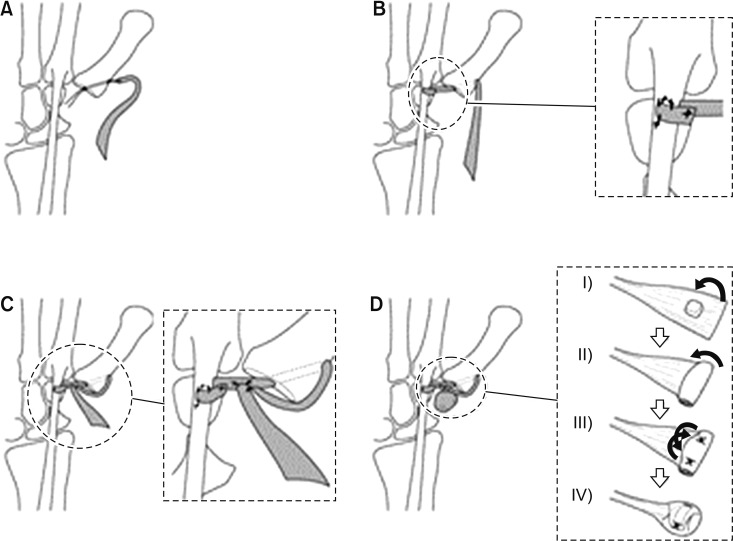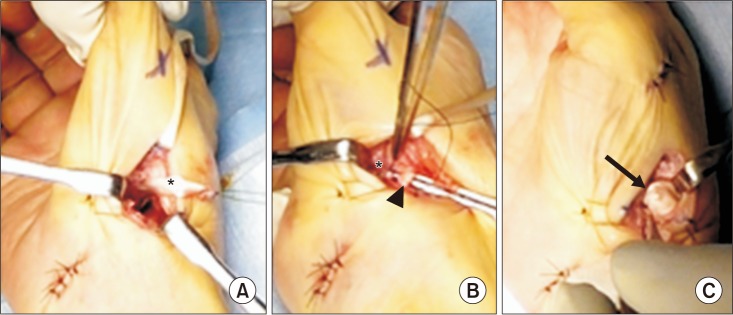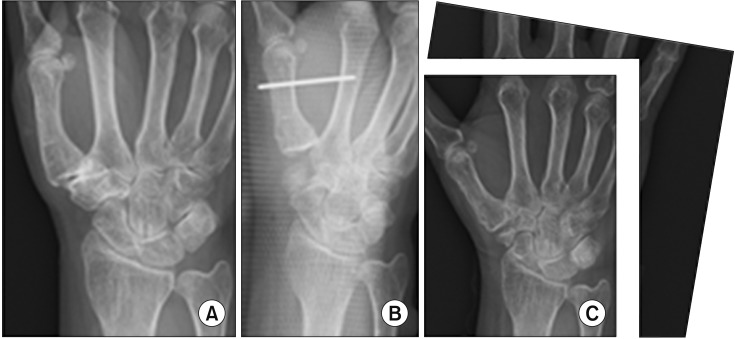1. Yuan F, Aliu O, Chung KC, Mahmoudi E. Evidence-based practice in the surgical treatment of thumb carpometacarpal joint arthritis. J Hand Surg Am. 2017; 42(2):104–112. PMID:
28160900.

2. Wolf JM, Delaronde S. Current trends in nonoperative and operative treatment of trapeziometacarpal osteoarthritis: a survey of US hand surgeons. J Hand Surg Am. 2012; 37(1):77–82. PMID:
22119601.

3. Burton RI, Pellegrini VD Jr. Surgical management of basal joint arthritis of the thumb. Part II: ligament reconstruction with tendon interposition arthroplasty. J Hand Surg Am. 1986; 11(3):324–332. PMID:
3711604.
4. Tomaino MM, Pellegrini VD Jr, Burton RI. Arthroplasty of the basal joint of the thumb: long-term follow-up after ligament reconstruction with tendon interposition. J Bone Joint Surg Am. 1995; 77(3):346–355. PMID:
7890782.

5. Gangopadhyay S, McKenna H, Burke FD, Davis TR. Five- to 18-year follow-up for treatment of trapeziometacarpal osteoarthritis: a prospective comparison of excision, tendon interposition, and ligament reconstruction and tendon interposition. J Hand Surg Am. 2012; 37(3):411–417. PMID:
22305824.

6. Lins RE, Gelberman RH, McKeown L, Katz JN, Kadiyala RK. Basal joint arthritis: trapeziectomy with ligament reconstruction and tendon interposition arthroplasty. J Hand Surg Am. 1996; 21(2):202–209. PMID:
8683047.

7. Rayan GM, Young BT. Ligament reconstruction arthroplasty for trapeziometacarpal arthrosis. J Hand Surg Am. 1997; 22(6):1067–1076. PMID:
9471079.

8. Belcher HJ, Nicholl JE. A comparison of trapeziectomy with and without ligament reconstruction and tendon interposition. J Hand Surg Br. 2000; 25(4):350–356. PMID:
11058002.

9. Davis TR, Brady O, Barton NJ, Lunn PG, Burke FD. Trapeziectomy alone, with tendon interposition or with ligament reconstruction. J Hand Surg Br. 1997; 22(6):689–694. PMID:
9457566.

10. Field J, Buchanan D. To suspend or not to suspend: a randomised single blind trial of simple trapeziectomy versus trapeziectomy and flexor carpi radialis suspension. J Hand Surg Eur Vol. 2007; 32(4):462–466. PMID:
17399871.

11. Eaton RG, Glickel SZ. Trapeziometacarpal osteoarthritis: staging as a rationale for treatment. Hand Clin. 1987; 3(4):455–471.
12. Imaeda T, Toh S, Nakao Y, et al. Validation of the Japanese Society for Surgery of the Hand version of the Disability of the Arm, Shoulder, and Hand questionnaire. J Orthop Sci. 2005; 10(4):353–359. PMID:
16075166.

13. Yang SS, Weiland AJ. First metacarpal subsidence during pinch after ligament reconstruction and tendon interposition basal joint arthroplasty of the thumb. J Hand Surg Am. 1998; 23(5):879–883. PMID:
9763266.

14. Vermeulen GM, Slijper H, Feitz R, Hovius SE, Moojen TM, Selles RW. Surgical management of primary thumb carpometacarpal osteoarthritis: a systematic review. J Hand Surg Am. 2011; 36(1):157–169. PMID:
21193136.

15. Wajon A, Vinycomb T, Carr E, Edmunds I, Ada L. Surgery for thumb (trapeziometacarpal joint) osteoarthritis. Cochrane Database Syst Rev. 2015; (2):CD004631. PMID:
25702783.

16. Miura T, Osuka K, Itoh S, Nakagawa T, Kawano H, Nakamura K. Early functional improvement after a modified ligament reconstruction tendon interposition arthroplasty for thumb basal joint arthritis. Hand Surg. 2008; 13(3):153–158. PMID:
19378359.

17. Pulvertaft RG. Tendon grafts for flexor tendon injuries in the fingers and thumb: a study of technique and results. J Bone Joint Surg Br. 1956; 38(1):175–194. PMID:
13295327.
18. Conway JE, Jobe FW, Glousman RE, Pink M. Medial instability of the elbow in throwing athletes: treatment by repair or reconstruction of the ulnar collateral ligament. J Bone Joint Surg Am. 1992; 74(1):67–83. PMID:
1734015.

19. Werthel JD, Dubert T. Use of the entire flexor carpi radialis tendon for basal thumb ligament reconstruction interposition arthroplasty. Hand Surg Rehabil. 2016; 35(2):107–113. PMID:
27117124.

20. Basar H, Basar B, Erol B, Tetik C. Ligament reconstruction and tendon interposition arthroplasty of the trapeziometacarpal joint with the use of the full thickness of the flexor carpi radialis tendon. Chir Main. 2012; 31(6):331–336. PMID:
23177995.
21. Kriegs-Au G, Petje G, Fojtl E, Ganger R, Zachs I. Ligament reconstruction with or without tendon interposition to treat primary thumb carpometacarpal osteoarthritis: a prospective randomized study. J Bone Joint Surg Am. 2004; 86(2):209–218. PMID:
14960663.
22. Downing ND, Davis TR. Trapezial space height after trapeziectomy: mechanism of formation and benefits. J Hand Surg Am. 2001; 26(5):862–868. PMID:
11561239.

23. Sebastin SJ, Puhaindran ME, Lim AY, Lim IJ, Bee WH. The prevalence of absence of the palmaris longus: a study in a Chinese population and a review of the literature. J Hand Surg Br. 2005; 30(5):525–527. PMID:
16006020.
24. Thompson NW, Mockford BJ, Cran GW. Absence of the palmaris longus muscle: a population study. Ulster Med J. 2001; 70(1):22–24. PMID:
11428320.
25. Spekreijse KR, Selles RW, Kedilioglu MA, et al. Trapeziometacarpal arthrodesis or trapeziectomy with ligament reconstruction in primary trapeziometacarpal osteoarthritis: a 5-year follow-up. J Hand Surg Am. 2016; 41(9):910–916. PMID:
27570226.








 PDF
PDF ePub
ePub Citation
Citation Print
Print



 XML Download
XML Download